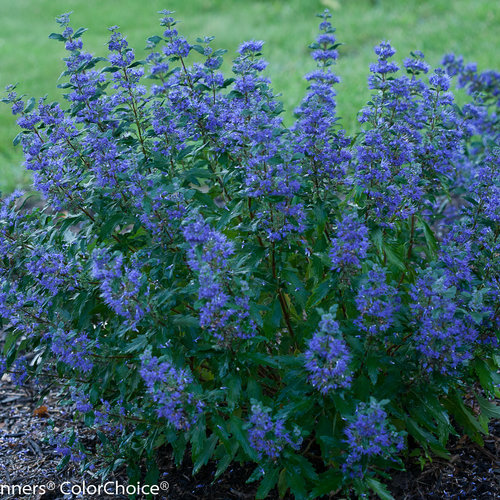Caryopteris: The Blue Butterfly Bush That Will
Caryopteris, also known as bluebeard, is a deciduous shrub that is native to Asia. It is a popular choice for gardens because of its beautiful blue flowers, which bloom in late summer and early fall. Caryopteris is also a magnet for butterflies, making it a great addition to any pollinator garden.
In this blog post, we will discuss the different types of Caryopteris, how to grow and care for them, and some of the benefits of adding them to your garden.
Types of Caryopteris
There are many different varieties of Caryopteris, each with its own unique characteristics. Some of the most popular varieties include:
- Caryopteris clandonensis 'Blue Mist': This variety is known for its long, cascading stems of blue flowers. It is a compact grower, reaching only 2-3 feet tall and wide.
- Caryopteris x clandonensis 'Heavenly Blue': This variety is a cross between Caryopteris clandonensis and Caryopteris incana. It has larger, more fragrant flowers than C. clandonensis 'Blue Mist'. It grows to 3-4 feet tall and wide.
- Caryopteris incana 'Silver Queen': This variety has silvery-gray leaves and lavender-blue flowers. It is a taller grower, reaching 4-5 feet tall and wide.
- Caryopteris x clandonensis 'Super Blue': This variety is a newer introduction that is known for its deep blue flowers. It is a vigorous grower, reaching 4-6 feet tall and wide.
Growing and Caring for Caryopteris
Caryopteris is a relatively easy plant to grow. It prefers full sun and well-drained soil. It is drought-tolerant once established, but it will benefit from regular watering during the summer months. Caryopteris is also a good choice for gardens in areas with hot, dry summers.
To care for Caryopteris, simply deadhead spent flowers to encourage new blooms. You may also need to prune the plant in late winter or early spring to shape it and remove any dead or damaged branches.
Benefits of Caryopteris
In addition to its beautiful flowers, Caryopteris also has a number of other benefits. It is a good choice for pollinator gardens because it attracts butterflies, bees, and hummingbirds. It is also a deer-resistant plant, making it a good choice for gardens in areas with deer problems.
Caryopteris is also a relatively low-maintenance plant. Once established, it requires little care other than regular watering and occasional pruning.
Conclusion
Caryopteris is a beautiful and versatile plant that is a great addition to any garden. It is easy to grow, drought-tolerant, and deer-resistant. It also attracts butterflies, bees, and hummingbirds. If you are looking for a long-blooming, low-maintenance shrub for your garden, Caryopteris is a great option.
Caryopteris, also known as bluebeard or blue mist spirea, is a genus of flowering plants in the family Lamiaceae. They are native to east Asia (China, Korea, Japan, Mongolia). Caryopteris are herbaceous plants or small shrubs growing to 1–4 m tall. The leaves are opposite, simple ovate to lanceolate, with an entire or crenate margin; they are often aromatic. The blue or white flowers are pollinated by butterflies and bumblebees. The fruit is a four-valved capsule containing four seeds.
Caryopteris are popular garden plants because of their attractive flowers, which bloom in late summer and early autumn. They are also relatively easy to care for, and can be grown in a variety of soils and conditions.
If you are interested in learning more about caryopteris, I recommend visiting the website Garden Wiki. This website provides a wealth of information about caryopteris, including species profiles, growing tips, and troubleshooting advice.
FAQ of caryopteris
Q: What is Caryopteris?
A: Caryopteris is a genus of flowering shrubs that are native to Asia and Australia. They are commonly known as bluebeard, blue spirea, or blue mist. Caryopteris shrubs are prized for their aromatic foliage and late summer flowers, which are typically blue, but can also be white or lavender.
Q: How do I care for Caryopteris?
A: Caryopteris shrubs are relatively easy to care for. They prefer full sun and well-drained soil. They are drought-tolerant once established, but they will benefit from regular watering during the summer months. Caryopteris shrubs can be pruned in the spring to shape them and encourage new growth.
Q: What are the pests and diseases of Caryopteris?
A: Caryopteris has no serious pest or disease problems. However, crown rot can be an issue in poorly drained soils. To prevent crown rot, plant Caryopteris in well-drained soil and avoid overwatering.
Q: How do I propagate Caryopteris?
A: Caryopteris can be propagated by seed, cuttings, or division. Seed propagation is the most common method. Seeds should be sown in the spring in a well-drained potting mix. Cuttings can be taken in the spring or summer. Division is the least common method of propagation, but it is a reliable way to increase the number of Caryopteris shrubs in your garden.
Q: What are the different varieties of Caryopteris?
A: There are many different varieties of Caryopteris, each with its own unique characteristics. Some popular varieties include:
- Caryopteris x clandonensis 'Blue Mist': This variety is a favorite for its bright blue flowers and aromatic foliage.
- Caryopteris incana 'Heavenly Blue': This variety has deep blue flowers and is a good choice for colder climates.
- Caryopteris x clandonensis 'Silver Queen': This variety has white flowers and silver-gray foliage.





Post a Comment for "Caryopteris: The Blue Butterfly Bush That Will"